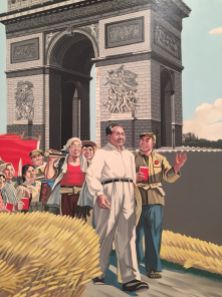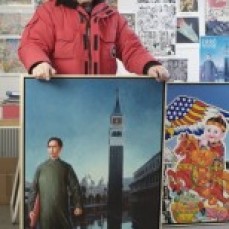On Mayday this year, the Mayor of Reykjavík, Dagur B. Eggertsson, open the exhibition Erró: Mao’s World Tour at Reykjavík Art Museum. Guðmundur Guðmundsson (b. 1932), better known as Erró, is probably the best known contemporary artist of Iceland. The Icelandic Pop artist is a regular fixture at the Hafnarhús site of the Reykjavík Art Museum, not surprising as it holds a total of about 2,000 items, including paintings, watercolours, graphic art, sculptures, collages and other works spanning the artist’s entire career.
Between 1972 and 1980, Erró painted the series Chinese Paintings, over 130 paintings which tell the story of a great leader who travels around the world. The Chinese Paintings made Erró famous internationally. The exhibition’s promotional material claims “the work well describes the artist’s witty humour”.
Each painting, like most other paintings by Erró from 1964 onwards, is based on a collage where Erró matches two images of different origins against each other: Chinese propaganda posters and Western tourist pictures from famous places. Erró pictures Chairman Mao on a triumphant tour around the world, when in reality Mao only made two trips out of China, both times to Moscow. Erró said: “I sent him on a trip around the world. I took him to Venice, Paris, New York. I made him a great traveller.” Although one might think that Mao’s was already a great traveller having experience the length and breadth of China in his own long march!
The imaginative series Chinese Paintings places Mao in various locations using his collage technique, cut together different times and realities, using depictions of Mao throughout his life including a Cultural Revolution favourite, the large oil painting
Some saw the series as a sarcastic reference to the wave of Maoism which inspired groups of Western artists, intellectuals and politicians following the student radical surge of 1968. Although the Cultural Revolution in the People’s Republic was at least two years old.The series of pictures on Mao travelling the world is a product of its time as they objectifies both the utopian dream of the future and the fear of the Chinese Cultural Revolution spreading around the world, invoked hope and warmth in the hearts of many, or induced a great terror. The young ML movement did adopt the style, icons and phraseology of the Cultural Revolution but for all that they were never simply Beijing’s banches in Western Europe as some would have you believe.
While Erró is a postmodern painter and pop artist in Paris, his brother Ari Trausti Guðmundsson was involved in left wing politics as chairman of Communist Unity (Marxist–Leninist) 1973-79 and the merger of the two Icelandic Maoist organizations 1979-83; although he put such youth indiscretions behind him and became a member of the Icelandic parliament in 2016 for the Left-Green Movement.
Part 2 : Sketch of Icelandic Maoism










